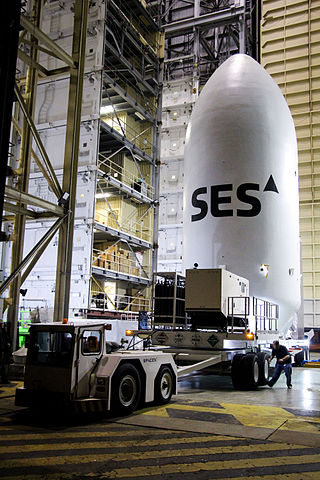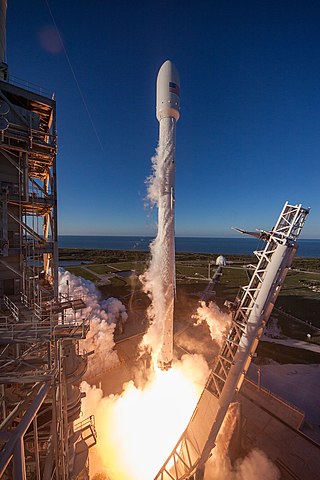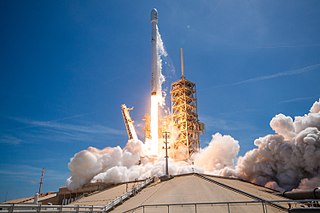
Boeing 702 is a communication satellite bus family designed and manufactured by the Boeing Satellite Development Center, and flown from the late-1990s into the 2020s. It covers satellites massing from 1,500 kg (3,300 lb) to 6,100 kg (13,400 lb) with power outputs from 3 to 18 kW and can carry up to approximately 100 high-power transponders.

Satmex was a company set up in Mexico in the mid-1990s through 2014 that operated space communication satellites that provide services to the Americas.

The Morelos satellites are a series of Mexican communications satellites. The first two operated between 1985 and 1998 and provided telephony, data, and television services over the territory of the Mexican Republic and adjacent areas. The third is now part of the MEXSAT constellation but carries the Morelos name.
Eutelsat 8 West C, known as Hot Bird 6 prior to 2012 and Hot Bird 13A from 2012 to 2013, is a geostationary communications satellite. Operated by Eutelsat, it provides direct-to-home (DTH) broadcasting services from geostationary orbit. The satellite was part of Eutelsat's Hot Bird constellation at a longitude of 13° East, until it was relocated to 8° West between July 2013 and August 2013.

USA-244, or Wideband Global SATCOM 6 (WGS-6) is a United States military communications satellite operated by the United States Air Force as part of the Wideband Global SATCOM programme. Launched in 2013, it was the sixth WGS satellite to reach orbit. It is stationed at a longitude of 135° West, in geostationary orbit. WGS-6 was procured by the Australian Defence Force for the U.S. Air Force, in exchange for participation in the programme.

ABS-3A is a communications satellite operated by ABS, providing coverage in the Americas, Europe, the Middle East, and Africa. It is positioned in geostationary orbit at 3° West, and offers C and Ku-band payload capacity to support video, data, mobility and government applications. The satellite is the first commercial communications satellite in orbit to use electric propulsion, providing a significant weight savings.

SES-9 is a geostationary communications satellite operated by SES S.A. It was launched from Cape Canaveral SLC-40 by a Falcon 9 Full Thrust launch vehicle on 4 March 2016.

SES-10, is a geostationary communications satellite awarded in February 2014, owned and operated by SES S.A. and designed and manufactured by Airbus Defence and Space on the Eurostar-3000 satellite bus. It is positioned at the 67° West position thanks to an agreement with the Andean Community to use the Simón Bolivar-2 satellite network. It replaces AMC-3 and AMC-4 to provide enhanced coverage and significant capacity expansion.
{{Infobox spaceflight | name = ViaSat-2 | names_list =

Falcon 9 flight 26 was the 26th Falcon 9 space launch by SpaceX, which launched both ABS's ABS-2A and Eutelsat's Eutelsat 117 West B to geostationary transfer orbit, that occurred on 15 June 2016 at 14:29 UTC.

Intelsat 35e, also known as IS-35e is an Intelsat high-throughput (HTS) geostationary communications satellite designed and manufactured by Boeing Satellite Systems on the Boeing-702MP satellite bus. It was launched on 5 July 2017.

BulgariaSat-1 is a geostationary communications satellite operated by Bulgaria Sat and manufactured by SSL. The satellite will provide high definition and ultra-high-definition television, very-small-aperture terminal (VSAT) communications, satellite news gathering relays, and other communications services, primarily to the Balkan Peninsula and Central/Western Europe.
SHERPA is a commercial satellite dispenser developed by Andrews Space, a subsidiary of Spaceflight Industries, and was unveiled in 2012. The maiden flight was on 3 December 2018 on a Falcon 9 Block 5 rocket, and it consisted of two separate unpropelled variants of the dispenser.
ABS-2A is an all-electric propulsion commercial communications satellite which is owned and operated by ABS. Co-located with ABS-2 at the 75°E orbital position, the satellite provides coverage over markets in South East Asia, Africa, MENA and Russia. The satellite is equipped with 48 Ku-band transponder and is designed for DTH services, cellular backhaul, VSAT, maritime and mobility solutions.

USA-263, or Wideband Global SATCOM 7 (WGS-7) is a United States military communications satellite operated by the United States Air Force as part of the Wideband Global SATCOM programme. Launched in 2015, it was the seventh WGS satellite to reach orbit. It is stationed at a longitude of 135° West, in geostationary orbit. WGS-7 was procured by the United States Air Force.

USA-272, or Wideband Global SATCOM 8 (WGS-8) is a United States military communications satellite operated by the United States Air Force as part of the Wideband Global SATCOM programme. Launched in 2016, it was the eighth WGS satellite to reach orbit. It is stationed at a longitude of 135° West, in geostationary orbit. WGS-8 was procured by the United States Air Force.

USA-275, or Wideband Global SATCOM 9 (WGS-9) is a United States military communications satellite operated by the United States Air Force as part of the Wideband Global SATCOM programme. Launched in 2017, it was the ninth WGS satellite to reach orbit. It is stationed at a longitude of 135° West, in geostationary orbit. WGS-9 was procured by the United States Air Force.

USA-291, or Wideband Global SATCOM 10 (WGS-10) is a United States military communications satellite operated by the United States Air Force as part of the Wideband Global SATCOM programme. Launched in 2019, it was the tenth WGS satellite to reach orbit. It is in geostationary orbit. WGS-10 was procured by the United States Air Force.










